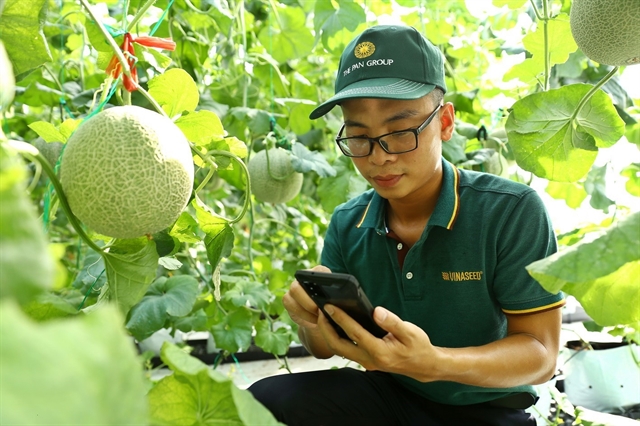 Society
Society

 |
| A man uses a smartphone to control the spraying system for a musk melon growing farm in Hà Nam. VNA/VNS Photo Minh Quyết |
HÀ NỘI — Việt Nam considers human resource development key to improving competitiveness in the agricultural sector, Minister of Agriculture and Rural Development Lê Minh Hoan said at a conference held on Tuesday in Hà Nội.
The conference on Cooperation in Training and Human Resource Development in Agriculture and Rural Areas organised by the Ministry of Agriculture and Rural Development (MARD) drew more than 300 attendees from key ministries, agencies, and enterprises.
It is expected to help foster collaboration agreements between corporations, organisations, and training institutes both inside and outside the ministry.
Speaking at the event, the minister said the role of training and human resources in rural development is an important premise for improving output and labour productivity, as well as competitiveness.
According to the ministry, there are around 50 universities and training schools that provide specialist instruction in agriculture, forestry, fisheries, and irrigation.
Human resource training for the agriculture industry currently faces limitations and obstacles as the number of students pursuing this major has declined.
Agriculture, forestry, irrigation, and fisheries students accounted for less than 2 per cent of the total number of around 520,000 students enrolled nationwide in 2022. This has a direct impact on the quality of human resources for agricultural research, and the transfer of science and technology, as well as agricultural production, processing, and business.
The cause is largely due to the low wages of employees in agriculture, forestry, and fishing, which are only about half of those in manufacturing, construction, and services.
Furthermore, some colleges continue to have a sponsored attitude and have lacked in enrolment, while others have aggressively reinvented their administration, content, and teaching techniques to satisfy the needs of students and the job market.
Investment in this area is, however, limited and teaching equipment is substandard and outdated.
“There should be policies to encourage students to study in social fields that are in high demand but difficult to enrol in, such as soil science, agronomy, post-harvest technology, and so on.
"We must assign tasks to institutions that show strength in training people in industries that are difficult to recruit for but are in demand by society,” said Prof. Dr. Nguyễn Thị Lan, Director of the Vietnam Academy of Agriculture.
MARD must prioritise investing in training institutions to provide quality programmes that are closely connected to market demands.
According to MARD, by 2030, the country aims to accomplish yearly vocational training for about 1.5 million rural employees, of which trained agricultural labourers must exceed 70 per cent.
It also aims to have the proportion of agricultural, forestry, and fishing employees with degrees and certifications from the elementary level or higher rise from 4.6 per cent in 2020 to 10 per cent in 2030.
To achieve these goals, the ministry will mobilise resources from the State and society to improve training for high-quality human resources and to research and expand training at college levels according to the Japanese model. — VNS